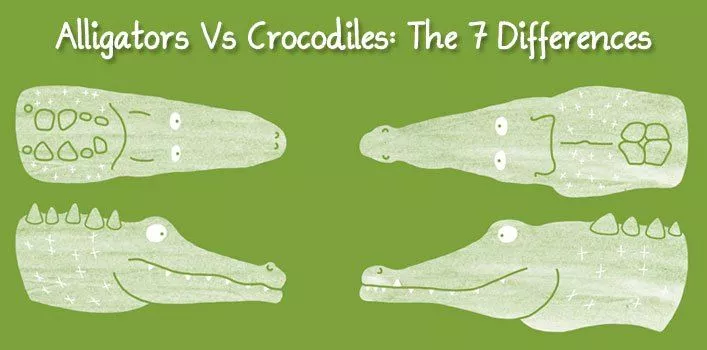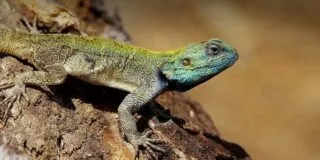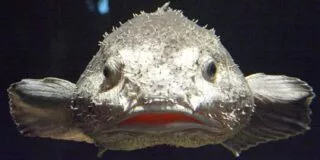We’ve all wondered what makes alligators and crocodiles different, because lets face it, to the ordinary person, they look pretty much the same.
But if you know what you’re looking for, you’ll be able to tell them apart instantly!
Check out the seven main differences between alligators and crocodiles below, along with a few interesting facts about the two of them!
There are three groups, or families, of crocodilians: the alligatoridae, consisting of alligators and caimans; the crocodylidae, consisting of the crocodiles; and the gavialidae, made up of only the gharial, a small fish-eating cousin of the larger, buffalo-munching crocs.
Across these three families are 23 different species, that have existed for more than 240 million years – that makes them 65 million years older than the dinosaurs!
These scaly beats are truly some of natures most perfectly designed, predatory killing machines.
A design that has been refined and shaped through evolution over a very long time. Ideally suited for water-life, some crocodilians can swim up to 20 miles per hour, and can run up to 11mph on land. Some of them can hold their breath for up to an hour.
They have perfectly located eyes for vision when their head are poking above the water, they have pretty amazing night vision too.
And don’t be fooled by the fact you can’t see their ears, their hearing is so sharp they can hear their offspring calling them from inside their eggs.
Their jaws can exert more pressure than any other living animal, and even more than a T-Rex some experts say!
Like a shark, a crocodilian never runs out of teeth, sharp new ones are always growing in as the old dull ones fall out, most of the time lost in some lovely piece of croc-chow.
But don’t be fooled, these teeth aren’t for cutting, just for gripping, as all crocodilians gulp down their food in large chunks, or just whole.
As you can imagine, there are many differences between the three families of crocodilians, especially between alligators and crocodiles. So let’s dive into seven interesting differences between these two brilliant beasts.
Difference #1 – The Shape of Their Snout
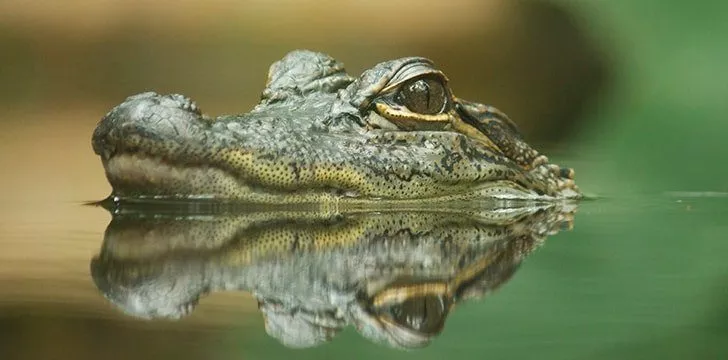
Okay, so lets start with the most obvious difference: the shape of the snout.
As a general rule of thumb goes; crocodiles have longer, V-shaped snouts, whereas alligators have shorter, U-shaped snouts.
The alligator’s broad snout is designed for strength, capable of standing up to the stress caused to the bone from the massive amounts of pressure that are used to break the shells of turtles and other hard-shelled creatures which form part of their diet.
The crocodile’s pointed snout isn’t quite as strong as the alligator’s, but it can still withstand the large amounts of pressure that a crocodile packs behind its bite.
However, crocodile’s jaws are often thought of as a more generalised jaw – ideal for the wide variety of prey that make up its diet.
There are exceptions to this rule, however – one example of such is the Indian Mugger Crocodile, which has a shorter, broader jaw not unlike an alligator’s, but certainly fits all the other classifications of being a crocodile!
Difference #2 – That Toothy Grin (or lack of)
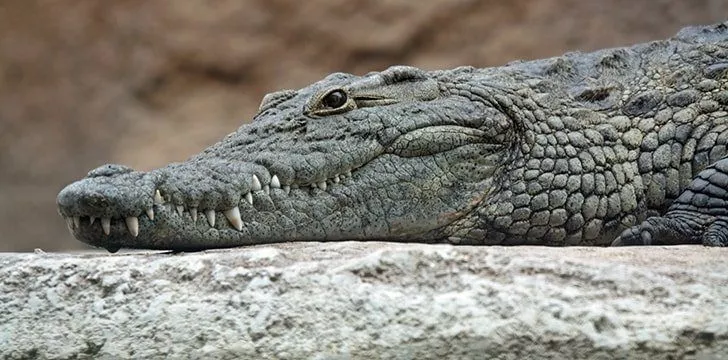
Another notable difference between crocodiles and alligators is the visibility of the teeth on the bottom jaw.
An alligator’s upper jaw is wider than its lower jaw, meaning that teeth on its lower jaw are almost completely hidden when its mouth is closed.
This is because an alligator’s upper jaw has small sockets on the inside that the teeth slot into when its mouth is closed.
A crocodile’s jaws, however, are roughly the same width. This means that the upper teeth interlock with the lower teeth when the mouth is closed.
A crocodile’s large fourth-tooth on the lower jaw is always visible when the mouth closes.
In fact – there is well-defined space in the upper jaw, behind the nostrils, for this lower fourth-tooth to slot into, making it always visible.
On top of this if look closely enough, you can see that an alligator’s teeth appear to more rounded, whereas a crocodile’s teeth tend to be more pointed.
But let’s just hope you never too close to actually notice that one!
Difference #3 – DPRs
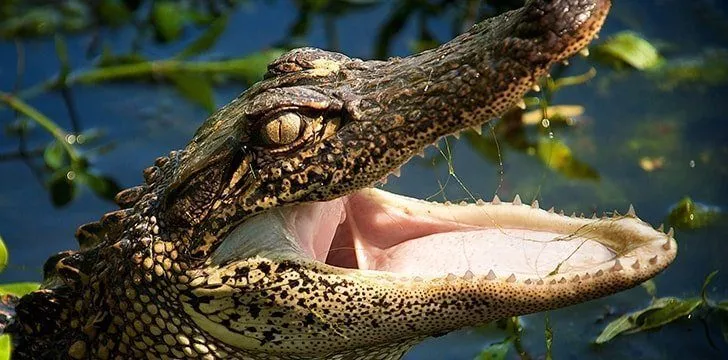
If you look at a crocodile or alligator’s head, especially the jaws and nose, you’ll see a lot of tiny black speckles, kind of like unshaven stubble.
These tiny dots are called Dermal Pressure Receptors (or DPRs), which are capable of detecting small pressure changes in water to help them locate and capture their prey.
Although both crocodiles and alligators have them covering their faces, crocodiles have similar organs covering the skin on their entire bodies whereas alligators do not.
Although the role the DPRs on crocodile skin play is currently unknown, scientists believe that they probably extend the sensory surface over the crocodile’s entire body.
Regardless of what they are for, they are a great and easy way to tell crocodile skin apart from alligator skin!
Difference #4 – Habitats
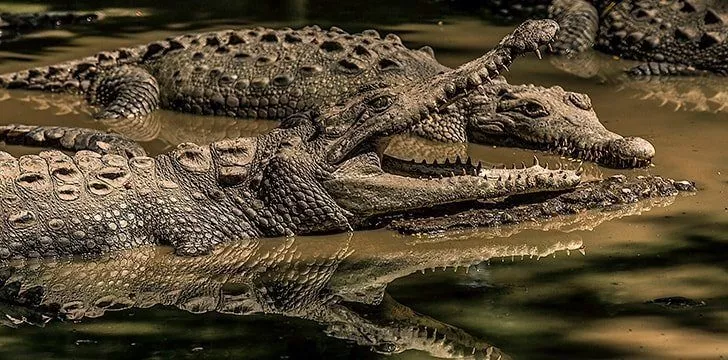
Alligators lack an ability to tolerate salt in such a way that a crocodile can.
Because of this alligators often prefer freshwater habitats, whereas crocodiles tend to favour more saline habitats.
However, it has been known for large alligators to sometimes wonder into estuaries, and rarely coastlines.
The spread of alligators around the world is also more limited than with crocodiles.
Alligators only naturally reside in America and India, whereas crocodiles reside naturally over much more of the world.
Difference #5 – Skin Color
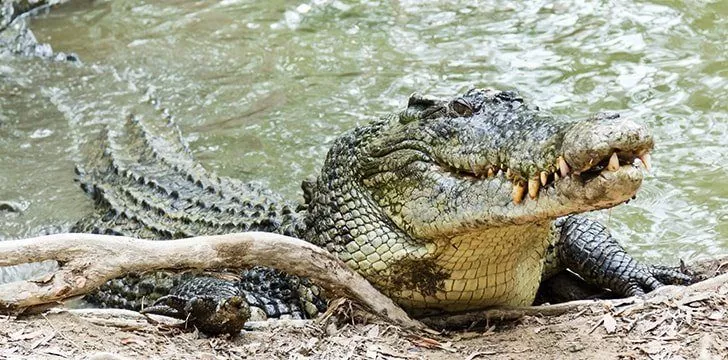
Pretty simple one – an adult alligator’s skin is usually a darker, grayish black color, but the skin of adult crocodiles is usually a lighter tan/brown color.
This is usually due to the type of habitats crocodiles and alligators live in.
Alligators tend to live in darker water, such as swamps, or slow-moving rivers.
Yet crocodiles tend to live in lighter colored waters, making a lighter skin-tone more suitable as camouflage.
On a side-note: young alligators can be more colorful, sometimes having white or yellow highlights on their black bodies.
Difference #6 – Lingual Salt-Glands
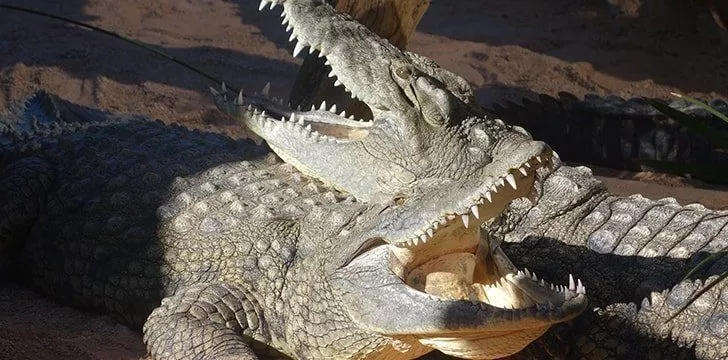
I think this is one of the most interesting, and definitely one of my favorites.
Crocodiles have functioning salt glands on their tongues, although not obviously noticeable, they can be seen when crocodiles bask in the sun out of water with their mouths open.
Now these are just modified saliva glands that allow crocodiles to excrete large amounts of salt from their surroundings, such as the water they are in.
This means a crocodile can tolerate more salty water than an alligator, such as tidal estuaries, coast-lines, and even the sea itself in some species!
Now this is something alligators have lost the ability to do at some point, so most alligators choose to remain in freshwater habitats like swamps, lakes or streams.
But, and this is the really interesting part, this suggests that crocodiles have quite an ancestral marine history.
In short, they could very well have held the ability to live in marine bodies of water for extended periods of time, or even permanently, migrating around the world through the seas – all of which certainly accounts for the widespread variety of crocodiles all across the world!
Difference #7 – Standing By Their Man
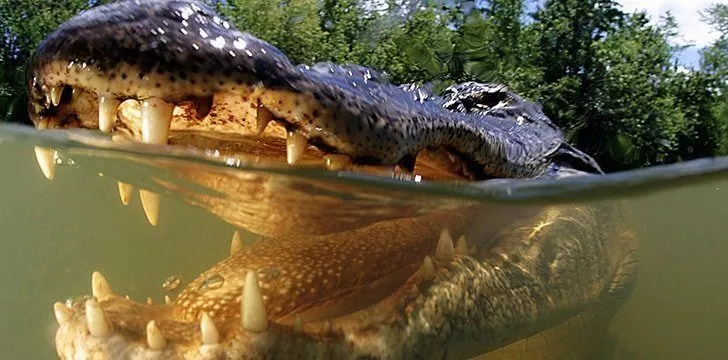
A recent study in a wildlife refuge found that up to 70 percent of female alligators mate with the same male year after year.
Although many male gators do play the field, many of the female alligators were found to display similar behavior with regards to mating as some birds who choose the same mate for life.
This behavior is not displayed in crocodiles however, as studies into crocodile’s mating and their young have shown that some batches of crocodile babies can contain genes from several different males.
So there you have it, some interesting facts that differentiate crocodiles from alligators.
Should you ever be unlucky enough to have one coming at you hopefully this article will have at least helped you identify your assailant!
